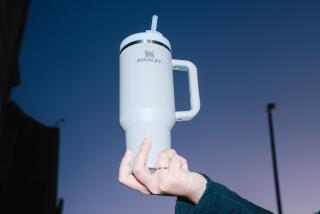Even Newer Bottles Can Be Valuable
- Share via
Question: In the general area of bottle collecting, how important is it to concentrate on older bottles? I am new to bottle collecting and was told that, unlike some other collectibles, older bottles do not necessarily translate into more value than newer bottles. What’s the score?--B.T.
Answer: Age does not automatically generate bigger bucks for a bottle collector.
Indeed, there are century-old gems, such as bitters bottles produced by physicians, that carry hefty price tags. But there also are newer collectible bottles, such as the Avon and Jim Beam variety that are issued particularly for collectors and that also are eagerly sought.
Actually, collectors say, it is difficult to define what constitutes an “old” or a “new” bottle in terms of evaluating a bottle’s worth. One bottle-collecting book defined antique as anything more than 100 years old.
Given the fact that blown-glass bottles have been traced back to the Roman Empire, “antique” appears to cover an enormous category. But, again, age does not automatically make a bottle valuable.
For example, bottles of more recent vintage may be valuable in their own right, because they establish some point in the history of a product. Coca-Cola bottles are a good case in point.
Like many other collectibles, ultimate value may come down to basic supply and demand or a particular trend or fad among collectors. That’s where the collector who has done his or her homework can usually make a profitable move.
If bottles--including soda, medicine and ink--are scarce but not moving because of a lack of demand, dealers may mark them down in price, giving the astute collector an opportunity to add to a collection at bargain prices.
Additionally, smart collectors keep abreast of new bottle trends in the knowledge that bottles in current production that have, say, unusual designs or shapes may become hot collectibles a few years from now. They know that once production of a particular bottle is concluded, its collectible value can take a sharp rise.
Q: I have been collecting Uncle Sam posters and related memorabilia over the years. How far back can an authentic Uncle Sam item go?--B.R.
A: Uncle Sam items appear to have surfaced in the mid-19th Century but certainly by the Civil War. Popular American artist Thomas Nast made the goateed American gentleman even more popular in the old Harper’s Weekly magazine. But James Montgomery Flagg’s World War I Uncle Sam recruiting poster with the “I Want You” message was the item that appears to have immortalized the old man with the famous top hat.
Surviving Montgomery original recruiting posters have sold for more than $300. Variations by Montgomery have carried price tags of more than $100.
But posters aren’t the only Uncle Sam items on the market that are grabbed up by collectors. There are Uncle Sam pins, watch fobs, political items, containers, ornaments and banks. A cast-iron Uncle Sam bank sold for more than $500 at a toy show.
Collectors appear to be more turned on by colorful Uncle Sam items--whether toys or posters--than anything in black and white. And if there is a holiday theme--such as the Fourth of July--so much the better in terms of value.
An interesting modern wrinkle, if collectors with foreign contacts can find them, are the negative U.S. propaganda posters featuring the Uncle Sam caricature.


